Visit Likir Monastery In Ladakh That Tells You About The Tibetan History In 2026
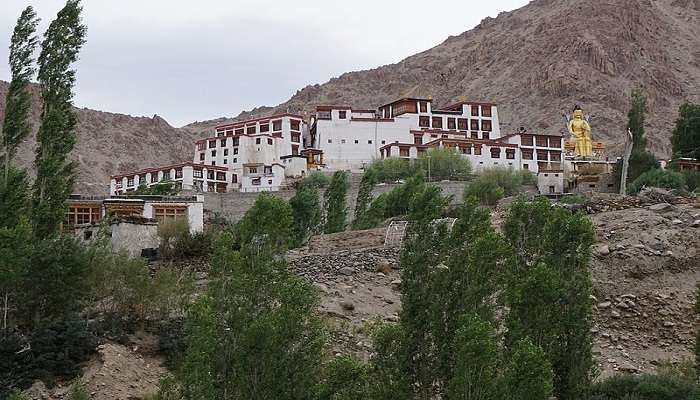
Nestled between the majestic landscapes of Ladakh, Likir Monastery still preserves the region’s rich culture and historical significance. The place is of utter spiritual importance. The monastery was founded in the 11th Century and is renowned for its stunning architecture, pretty murals and peaceful atmosphere. It is located almost 52 km west of Leh, the capital of Ladakh, offering visitors a glimpse of Tibetan Buddhism. There are statues of Bodhisattvas, where resident monks perform their spiritual practices daily. Clear blue skies and barren mountains surround the monastery. Travellers seek solace in the monastery’s pristine beauty in Ladakh.
History Of Likir Monastery
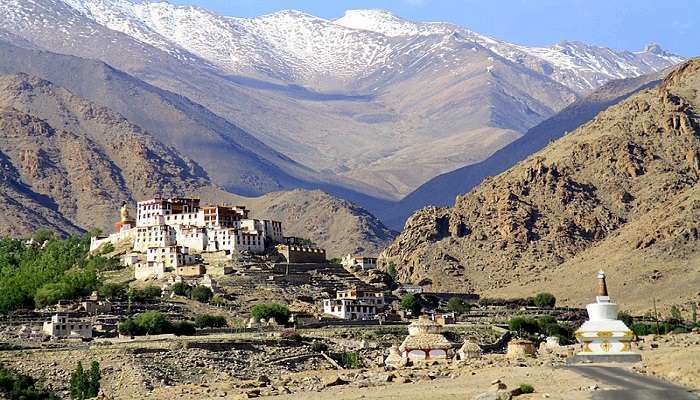
This beautiful monastery is situated in the Ladakh region of India, with a profound history dating back several centuries. Likir Monastery was built in the 11th Century by Lama Duwang Chosje. The monastery is one of the oldest monasteries in India. The name ‘Likir’ translates to ‘Naga’, which means encircled, which tells that its establishment was associated with the protection from the mythical serpent spirits believed to inhabit the region back then.
Likir became a prominent spot in the Gelugpa Order. Through the years, the monastery has endured prosperity and decline, witnessing both invasions and renovations. The monastery still preserves its spiritual and architectural integrity. Its main attractions are the golden statue of Maitreya Buddha, beautiful wall paintings, and a collection of scriptures and artifacts.
Must Read: Things To Do In Ladakh
Tourist Attractions Near Likir Monastery
Likir Monastery in Ladakh serves as a place of peaceful contemplation for travellers and a religious centre of Buddhism. Visitors seek peace in this place, surrounded by pretty landscapes. Here are some places near Likit Monastery that you can visit:
1. Alchi Monastery
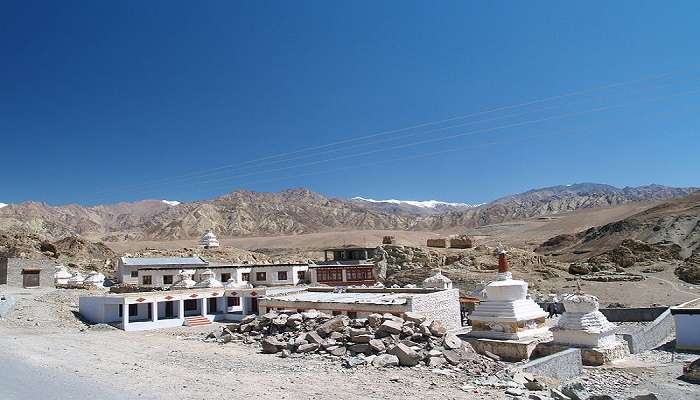
Alchi Monastery, also known as Alchi Gompa, is one of Ladakh’s oldest monastic complexes. The monastery dates back to the 10th Century. It is known for its unique Kashmiri-style Buddhist architecture. It includes all the exquisite wall paintings, detailed wood carvings and several statues of Buddhist deities. The monastery complex has numerous temples. The ‘Dukhang’ (Assembly Hall), Sumtsek Temple, and the Manjushri Temple are the main temples. Alchi is located in a beautiful village by the banks of the Indus River, surrounded by apricot orchards and scenic mountains.
Location: Alchi Village, Leh District, Ladakh 194106
Distance From Likir Monastery: 21 km
2. Saspol Caves
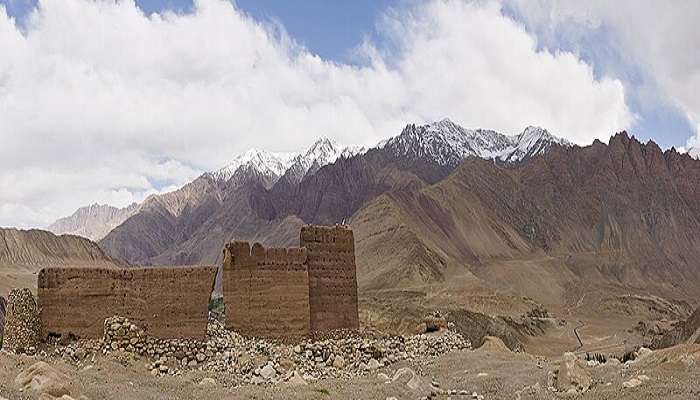
Saspol Caves are found near the village of Saspol. These ancient rock-cut caves house some of the oldest surviving Buddhist murals in Ladakh and India. The caves previously served as a meditation chamber for Buddhist monks and contain outstanding frescoes depicting Buddhist deities and scenes from the Jataka Tales. All of the artwork dates back to the 12th Century, which shows the legacy and artistic spirituality of early Tibetan Buddhism in the region. Saspol Caves are a hidden gem offering a serene and mystical atmosphere in Ladakh.
Location: Saspol Village, Leh District, Ladakh 194101
Distance From Likir Monastery: 15 km
Suggested Read: Sindhu Ghat
3. Basgo Monastery
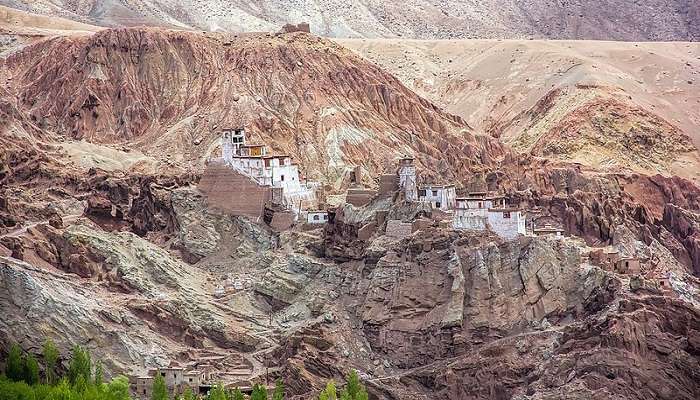
Basgo Monastery is also known as Basgo Gompa. It is a historical complex and another Buddhist monastery that is perched on a hill near the town named Basgo. It has several temples and ruins, including the Chamchung and Serzang Temple. These temples are known for their ancient murals and scriptures. Basgo Fort is adjacent to Basgo Monastery and was a defensive stronghold during ancient times. It also protected the area from invasions during the medieval period. The fort’s ruins stand as a testament to the region, offering panoramic views of the Indus Valley. Basgo is also known for the scenic beauty of the barren lands around it.
Location: Basgo Village, Leh District, Ladakh 194101
Distance From Likir Monastery: 16 km
Things Not To Miss In The Monastery
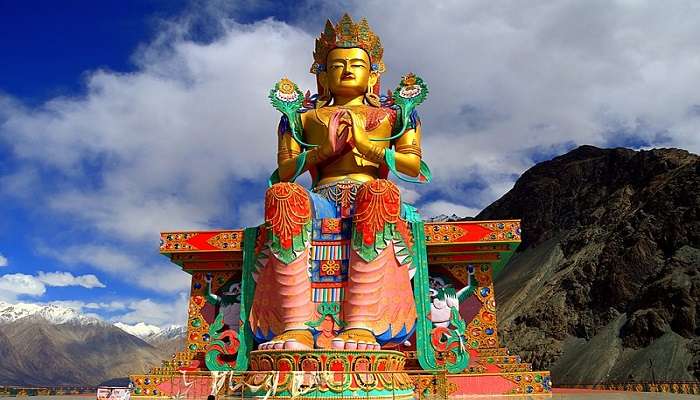
While visiting Likir Monastery, several key experiences and sights should not be missed for totally appreciating this place’s cultural and spiritual significance.
Maitreya Buddha Statue: This 23-metre-high statue is placed in the centre of Likir Monastery. It is adorned with intricate details and vibrant colours and represents future enlightenment in Tibetan Buddhism.
Wall Paintings & Murals: Ancient wall paintings and murals depict Buddhist teachings. Beautiful mandalas cover the walls. The paintings are masterpieces of storytelling.
Monastic Life: Visitors should witness resident monks’ daily rituals and practices. Observe the monks engaged in prayers, meditation sessions and ceremonial rituals.
Monastery Museum: This small museum showcases a wide collection of ancient artefacts, religious relics, and historical manuscripts. It also serves as an education hub, providing insights into Tibetan Buddhism.
Suggested Read: Restaurants In Leh
Local Cuisine Of Ladakh
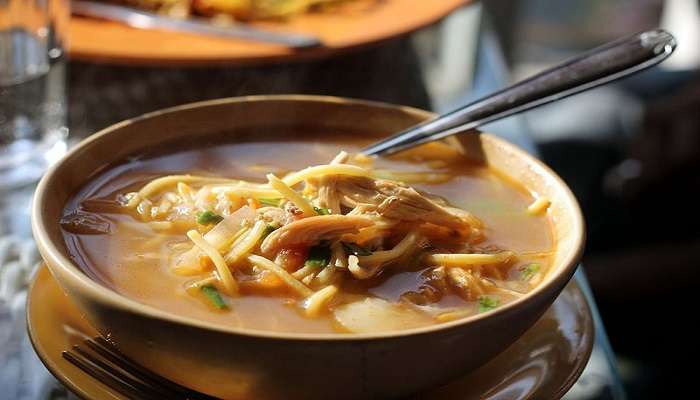
Ladakh’s cuisine is renowned for its flavorful fusion. These well-known recipes perfectly capture the variety and flavour of the region.
Thukpa: It is a staple food of Ladakh households. It consists of noodles simmered in a flavourful soup made with vegetables or chunks of meat and Tibetan spices.
Momos: Momos are steamed dumplings filled with minced meat or vegetables seasoned with herbs and spices. They are crescent-shaped and served with spicy tomato or mustard sauce.
Chang: Chang is a barley beer served in Ladakh. Household families brew it by fermenting barley grains and yeast, resulting in alcoholic beverages with slightly sour tastes.
Skyu: Skyu is a filling stew that combines soup and stew. It consists of a small ball made from wheat flour called ‘Skyu’ and cooked with chunks of meat or vegetables.
Paba: This dish is made from roasted barley flour and water. The flour is roasted until golden brown and then mixed with boiled water for a porridge-like consistency. Paba is eaten as a breakfast dish besides butter tea and is a staple food for residents in Ladakh.
Further Read: Temples In Ladakh
Likir Monastery in Ladakh stands as a timeless sanctuary of spirituality and cultural splendour of the region. The ancient origins of this place offer profound insights into Tibetan Buddhism and the way of life in the Himalayan Region. Visitors are drawn to its delicate architectural splendour and the peaceful ambience that visitors would embrace on their trip to Ladakh. A spiritual essence permeates its surroundings. Whether exploring the places nearby, attending the religious festivities of the monastery or simply soaking into the broad vistas of the Himalayan Region, Likir Monastery leaves you with a lasting impression.
For our editorial codes of conduct and copyright disclaimer, please click here.
Cover Image Credit: Deepank Ranka for Wikimedia Commons
Frequently Asked Questions About Likir Monastery
What is the history of Likir Monastery?
Likir is mentioned in one of the Ladakhi Chronicles. King Lhachen Gyalpo erected these chronicles. They originally belonged to Tibetan Buddhism’s early order of Kadampa.
Why is Alchi Monastery famous?
Alchi Monastery is one of the most famous monasteries in Ladakh. It was founded by the scholar Rinchen Zangpo in the 10th century. It is very famous as it is built on flat ground unlike the other monasteries of Ladakh that are built atop a hill.
Which is the first largest monastery in India?
Tawang Monastery is a Buddhist Monastery located in Tawang, Arunachal Pradesh. This monastery is the largest monastery not only in the state but in the entire India. It is situated in the serene valley of Tawang Chu.
Where do monks sleep in a monastery?
According to some orders, monks in a monastery don’t have a cell to sleep in, rather they sleep in a large room called a dormitory. The room is called a cell because it has the size and look of a small house.
What is another name for Ladakh?
Another name for Ladakh is “Khapa Chan”. Khapa Chan means a land of snow. Ladakh is a cold desert lying in the great Himalayas, particularly on the eastern side of Jammu and Kashmir.
People Also Read:
Nechung Monastery Gyuto Tantric Monastery Sherabling Monastery

We all have to begin somewhere. This is where I start and I hope that my writings encourage you to begin. To new beginnings and conquering new places!











